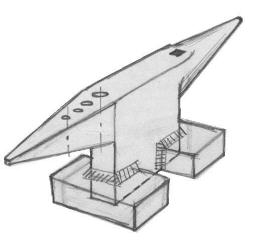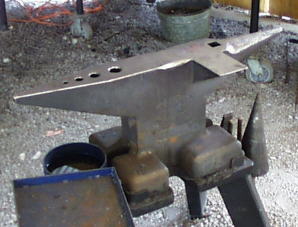
Like a lot of blacksmiths today I've thought about making my own anvil more than once.
As a machine designer I look at things a little differently than most.
I think I have a much more elegant solution than cutting the whole from plate and provides a method to make the hardy hole.
It requires some heavy welding and possibly some machining.
The body starts as a rectangular piece of steel plate (A-36 or 4140).
When buying new plate you pay for the rectangle. This design produces little waste.
The waist notches can be cut by the steel service center or in your shop.
The horn is formed separately either from plate or a piece of shafting.
It starts as a blank torch cut in two dimensions.
After rough cutting and grinding off the torch swarth the horn can be forged or machined.
Note the shape of the weld preps.
The heal can have the hardy hole groove and weld prep machined on a milling machine or a shaper.
It can also be built up by welding alone.
The asymmetrical square horn shown at the top is my idea.
This provides the "Euro" style square horn plus a long straight edge on one side.
The base is widened by the addition of square bar welded around the base.
NOTE: The above was written in 1997 when heavy steel plate was relatively inexpensive and readily available in alloy steels from J.T. Ryerson.
Since then there has been a huge decline in the US steel industry and current steel prices make it more affordable to purchase good imported anvils than to buy new steel plate.
A fabricated anvil of dubious quality can now cost you more than a real professional product.
Ernie Leimkuhler <stagesmith @ earthlink.net>
has a posting of his method of anvil making similar to this at
METAL WEB NEWS.
The instructions are lavishly illustrated with photographs of each step of his process.
Go to Blacksmithing see "Picture Instructions for making a 275 lb. Anvil"

LEFT: This is an anvil design based on the Hofi anvil below which is being produced in cast steel.
After looking at it a while I realized it could have been made from plate or may have originaly been designed to be made from plate.
The face is relatively narrow (3 to 3-1/2"). The heavy feet makes this a very stable design and may also serve as upsetting blocks.
The design when cut from plate is quite efficient.
Except for broaching the hardy hole this anvil can be fabricated in almost any welding shop.
 Photo of the Hofi Anvil, pattern by Phil Cox.
Photo of the Hofi Anvil, pattern by Phil Cox.
The stand it is mounted on accentuates some
of the features. The heavy perpendicular
feet act like upsetting blocks and the
space in between allows work pass
through the stand to the floor if needed.
The graduated "pritchell" holes are very
useful and all the demonstrators using the
anvil made use of the different sizes. I
know several people that like an anvil with
a narrow face and this one certainly has
one.
This is a cast steel anvil wt 265 pounds.
Uri Hofii is also known for his hand hammers.
References and Links





 Photo of the Hofi Anvil, pattern by Phil Cox.
Photo of the Hofi Anvil, pattern by Phil Cox.
städ, incus, aambeeld, batente